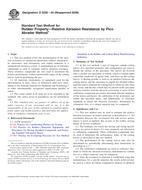We need your consent to use the individual data so that you can see information about your interests, among other things. Click "OK" to give your consent.
ASTM C1523-10
Standard Test Method for Determining Modulus, Tear and Adhesion Properties of Precured Elastomeric Joint Sealants
STANDARD published on 1.3.2010
The information about the standard:
Designation standards: ASTM C1523-10
Note: WITHDRAWN
Publication date standards: 1.3.2010
SKU: NS-11690
The number of pages: 6
Approximate weight : 18 g (0.04 lbs)
Country: American technical standard
Category: Technical standards ASTM
The category - similar standards:
Annotation of standard text ASTM C1523-10 :
Keywords:
Precured elastomeric joint sealant, Sealants, Tear testing, Joint movement, Modulus, ICS Number Code 83.060 (Rubber)
Additional information
| Significance and Use | ||||||||||||||||
|
Seals are manufactured in flat extruded shapes and are primarily used to span joint openings. The seal is adhered to construction substrates utilizing a liquid applied adhesive, to seal building openings such as panel joints, metal flashing joints or other joints in place of conventional liquid applied sealants. In actual use, failure of an applied seal in an active joint is usually manifested by cohesive failure of the seal; adhesive failure between the adhesive and the substrate; adhesive failure between the adhesive and the seal; cohesive failure of the substrate or tear propagation parallel to the joint length. This test method can be used for testing the adhesion of the adhesive to the substrate and to the seal, tensile load at various strains and tear resistance at various strains after the specimens are exposed to wet, cold, hot and artificial weathering conditionings. All or some of these properties are experienced on actual job sites. |
||||||||||||||||
| 1. Scope | ||||||||||||||||
|
1.1 This test method describes a laboratory procedure for measuring modulus, tear, joint movement ability and adhesion properties of applied, Precured Elastomeric Joint Sealants, hereinafter referred to as “applied seal” and if not applied, hereinafter referred to as “seal,” on portland cement mortar as a standard substrate and or other substrates. It tests these properties after dry, wet, frozen, heat aged or artificially weather-aged conditionings, or both. 1.2 The values stated in SI units are to be regarded as the standard. The values given in parentheses are provided for information only. 1.3 This standard does not purport to address all of the safety concerns, if any, associated with its use. It is the responsibility of the user of this standard to establish appropriate safety and health practices and determine the applicability of regulatory limitations prior to use. 1.4 The committee with jurisdiction over this standard is not aware of any similar standard published by another committee or organization. |
||||||||||||||||
| 2. Referenced Documents | ||||||||||||||||
|
Similar standards:
Historical
1.1.2012
Historical
15.12.2011
Historical
1.7.2009
Historical
15.5.2014
Historical
1.5.2012
Historical
1.1.2010
We recommend:
Technical standards updating
Do you want to make sure you use only the valid technical standards?
We can offer you a solution which will provide you a monthly overview concerning the updating of standards which you use.
Would you like to know more? Look at this page.



 ASTM D2000-12
ASTM D2000-12 ASTM D2084-11
ASTM D2084-11 ASTM D2228-04(2009)..
ASTM D2228-04(2009).. ASTM D2229-10(2014)..
ASTM D2229-10(2014).. ASTM D2230-96(2012)..
ASTM D2230-96(2012).. ASTM D2240-05(2010)..
ASTM D2240-05(2010)..
 Cookies
Cookies
